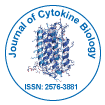SARS Lymphopenia and Hydrocortisone -Treated Patients Lymphocyte Status
Received: 17-Mar-2022 / Manuscript No. jcb-22-57604 / Editor assigned: 19-Mar-2022 / PreQC No. jcb-22-57604 / Reviewed: 07-Apr-2022 / QC No. jcb-22-57604 / Revised: 02-Apr-2022 / Published Date: 14-Apr-2022
In November 2002, a worldwide outbreak of severe acute respiratory syndrome (SARS) infected approximately 8000 people in 29 countries, resulting in 774 fatalities by August 2003. In Hong Kong, 1755 people were diagnosed with SARS, with 299 of them dying. SARS was discovered to be caused by an RNA coronavirus (CoV), fittingly named SARS-CoV, a member of the coronaviridei family of viruses that causes gastrointestinal, respiratory, and systemic disorders in animals [1]. OC43 (HCoV-OC43) and HCoV-229E are two members that have long been recognized to cause the common cold in humans. SARSCoV caused an influenza-like syndrome of malaise, rigors, fatigue and high fevers, which progressed to atypical pneumonia, with shortness of breath and poor oxygen exchange in the alveoli. Respiratory failure was the most prevalent cause of mortality due to respiratory insufficiency. Antibacterial, antiviral, and supra-physiological dosages of glucocorticoids were used to treat the illness empirically. Lympopenia and neutropenia were also prevalent symptoms in SARS patients.
The human paramyxovirus respiratory syncytial virus (RSV) is the most common cause of viral lower respiratory tract illness in newborns and children across the world. Lympopenia (and neutrophilia) are other symptoms of the condition, which are more severe in youngsters hospitalised to the critical care unit. Ebola has also been linked to lymphopenia (and neutropenia)[2]. As a result, there appears to be a link between viral infections and lymphopenia, and the question now is whether the viruses cause it directly. In the case of SARS, a research by Gu et al. was emphasised in a review published in Nature Reviews Immunology.
The prevalence rate of 27.3 percent statistically refutes the authors’ argument that SARS-CoV infection of lymphocytes impacts illness outcome, let alone causes lymphopenia. Furthermore, whereas SARS patients who did not receive exogenous glucocorticoids showed lymphopenia, those who were administered steroids had their lymphocyte count drop even further. This strongly shows that glucocorticoids had a role in lymphopenia development. The lymphopenia in the first group might simply have been a stress response prognosticator involving the hypothalamic–pituitary–adrenal (HPA) axis. Under high stress, a functional HPA axis is capable of secreting 225-440 mg of cortisol and attaining blood levels of 830-7220 mol/L.
In 29 countries, the Severe Acute Respiratory Syndrome (SARS) epidemic in 2002–03 caused illness in over 8000 people and death in 744. Lympopenia and neutrophilia were both symptoms of SARS, as well as respiratory syncytial virus (RSV) and Ebola infections. SARS coronavirus (CoV) infection of lymphocytes, neutrophils, and macrophages has been disputed as a cause of lymphopenia, although there is no conclusive evidence [3]. Lympopenia can be triggered by glucocorticoids; therefore any debilitating ailment with a stress mechanism involving the hypothalamic–pituitary–adrenal axis has the potential to cause lymphopenia. Cortisol levels are greater in RSV and Ebola patients, and cortisol levels were higher in SARS patients with lymphopenia before any steroid treatment. In addition, glucocorticoids suppress the generation of proinflammatory lymphocytes.
A major illness like SARS should have elicited a stress response involving the HPA axis and cortisol production. Cortisol would have forced lymphocytes to move out of the peripheral circulation at first, and then apoptosis would have killed them [4]. The use of exogenous glucocorticoids, on the other hand, compounded the whole issue of lymphopenia (and neutrophilia) in SARS. However, all signs point to glucocorticoids, whether endogenous or exogenous, as the primary mediators of lymphopenia (and neutrophilia). Second, the up- and down-regulation of numerous lymphocytes, as well as their prognostic implications for SARS, should be viewed with caution in a scenario where the immune system must have been substantially impaired by exogenous glucocorticoids.
References
- Anand K, Ziebuhr J, Wadhwani P (2003) Coronavirus main proteinase (3CLpro) structure: basis for design of anti-SARS drugs. Science 300: 1763-1767.
- Ho JC, Ooi GC, Mok TY (2003) High-dose pulse versus nonplus corticosteroid regimens in severe acute respiratory syndrome. Am J Respir Crit Care Med, 168: 1449-1456.
- Sung JJ, Wu A, Joynt GM (2004) severe acute respiratory syndrome: report of treatment and outcome after a major outbreak. Thorax 59: 414-420.
- Lee N, Hui D (2003) A major outbreak of severe acute respiratory syndrome in Hong Kong . New Engl J Med 348: 1986-1994.
Indexed at Google Scholar Crossref
Indexed at Google Scholar Crossref
Indexed at Google Scholar Crossref
Citation: Wilson J (2022) SARS Lymphopenia and Hydrocortisone-Treated Patients Lymphocyte Status. J Cytokine Biol 7: 408.
Copyright: © 2022 Wilson J. This is an open-access article distributed under the terms of the Creative Commons Attribution License, which permits unrestricted use, distribution, and reproduction in any medium, provided the original author and source are credited.
